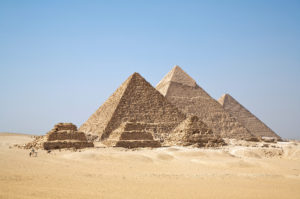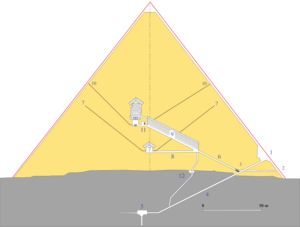
You probably don’t usually think of particle physics and the Great Pyramid of Giza as having much in common. In some ways, the two seem diametrically opposed: the Giza Pyramid is the pinnacle of past achievement while particle physics relies on cutting-edge technology. The Great Pyramid of Giza is the only one of the seven wonders of the ancient world that is still standing. It is the tomb built over 4,500 years ago as a monument to Pharaoh Khufu. Little is known about how such a massive structure was built so long ago or what the internal structure looks like. Historians and archaeologists have been trying to uncover these mysteries for centuries. On the other hand, particle physics is often portrayed in movies and TV as a futuristic discipline in which scientists develop futuristic weapons. As a result, when an article was published in Nature on November 2 with the title “Discovery of a big void in Khufu’s Pyramid by observation of cosmic-ray muons,” there was a media frenzy.
What are cosmic rays?
Though we sometimes think of science as a means to developing a more technological future, it is also importantly a means to understanding the secrets of the past. Much of the information we have about the origins of the universe and the evolution of galaxies has come from studying the fundamental building blocks of matter. For example, some particle physicists study the atomic nuclei falling toward Earth’s surface in cosmic rays. Studying this material provides insight into how galaxies are formed and how they evolved chemically.
When the protons and other nuclei in cosmic rays collide with nuclei in Earth’s atmosphere, pions are created. Pions then quickly decay and form muons. Muons have a negative charge like an electron but 207 times greater mass. The Earth’s atmosphere slows down all of the particles in the cosmic ray showers that are constantly raining down on the Earth. Because of their relatively large mass, muons are actually able to reach the surface of the Earth, unlike lighter particles. Detectors on or near the Earth’s surface can then detect these particles. In order to eliminate background noise from measurements, some particle detectors are placed deep underground in mines and caves. Learn more about what it is like to conduct scientific research in an underground laboratory in Underground Science at SNOLAB.
Using muon detection as an imaging technique
As early as 1955, physicists have taken advantage of the ability of muons to penetrate through rock by measuring the thickness of rock formations using muon flux (the amount of muons passing through an area of a detector). The concept of these measurements is similar to x-ray imaging. An x-ray is a high-energy form of electromagnetic radiation. Due to their high energy, x-rays are not readily absorbed by soft tissue such as skin and organs but are absorbed by denser structures like bone. If an x-ray source is aimed at a human arm and a film is placed on the other side of the arm, an image of the bones will be formed by the relatively low number of x-rays that reach the film behind the bones. Similarly, physicists working with cosmic rays realized that they could image large structures by taking advantage of the the fact that higher-density materials (such as stone) will absorb more muons than areas of lower density (such as air).
Muon detection is a promising method for studying the pyramids because we can infer information about the internal structure without having to destroy it or to open up sealed sections. In 1970, researchers first attempted to use muon flux to search for cavities in the Giza pyramid. By placing detectors in the subterranean chamber (label 5 in the schematic diagram below), they were able to image a region of the pyramid occupying approximately 19% of the pyramid’s total volume. No new chambers were discovered in this region. Since then, detector technology has become more sensitive to smaller amounts of muon flux. In 2015, a team comprised of researchers from universities in Japan, France, and Egypt tried once again to use muon detection to search for cavities within the great stone structure. They tried three methods of muon detection, and this time they were successful.

Detection of the new void
First, they placed detectors inside the Queen’s chamber and in the corridor outside. These measurements were taken over the course of several months so that a relatively high number of muons would be recorded, making the measurements more accurate. The measured muon signals were compared with the signals they would expect based on what was previously known about the structure of the pyramid. From this method, they detected an unexpected excess of muons coming from the region above the Great Gallery. From this excess, the researchers inferred that there was an unexpected region of air inside the pyramid. The excess of muons is about the same as the excess of muons that pass through the Great Gallery, meaning the the newly detected void is approximately the same size as the Great Gallery. In order to verify their findings, the researchers used two additional muon-detection methods over the course of the next two years with detectors placed in different locations. Signals from all three methods pointed to the same conclusion: there exists a void in the stone structure above and parallel to the grand gallery.
While this information doesn’t directly tell us why or how the pyramid was built the way that it was, it adds to our knowledge about the structure and may help archaeologists infer something about the design. Although, since the publication of the article, there has been some controversy over whether or not this is actually new information, this research still clearly demonstrates that cosmic rays may be useful for understanding not only events that happened billions of years ago but also events that happened much closer to home. And importantly, this shows that science and the humanities have something to offer each other. As scientific advances continue to shape the political and cultural landscape of our future, we will also understand more and more about our past.
Peer edited by Mimi Huang and Jon Meyers.
Follow us on social media and never miss an article: